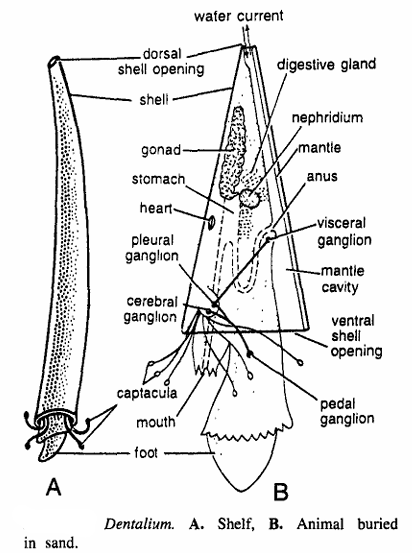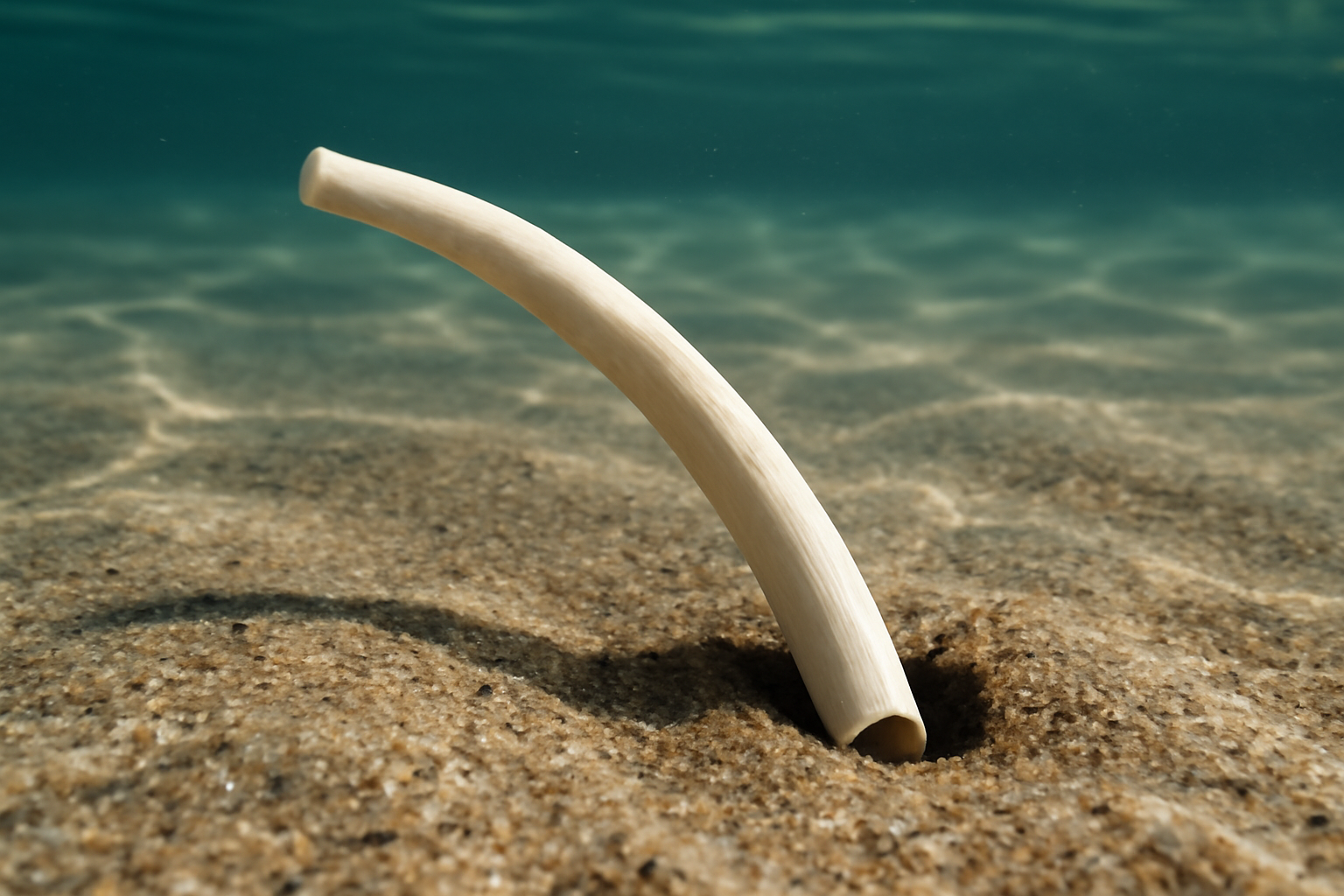Dentalium: Morphology, Classification, Habitat, and Cultural Significance of the Tusk Shell Mollusc
Dentalium, commonly known as tusk shells or tooth shells, is a genus of marine molluscs belonging to the class Scaphopoda. These animals are named for their distinctive slender, tubular, tusk-like shells open at both ends, which have fascinated biologists and humans alike for centuries. This species inhabit sandy and muddy marine substrates and are found largely buried in sediments. Their unique morphology, specialized feeding apparatus, and ecological role contribute to the biodiversity of benthic marine ecosystems. Historically, the shells of Dentalium have held significant cultural importance among indigenous peoples as currency, jewelry, and ceremonial items.
Classification of Dentalium
| Taxonomic Rank | Name | Characteristics |
|---|---|---|
| Kingdom | Animalia | Multicellular, eukaryotic organisms |
| Phylum | Mollusca | Soft-bodied, unsegmented animals with a mantle |
| Class | Scaphopoda | Marine molluscs with tubular, tusk-shaped shells |
| Order | Dentaliida | Scaphopods with elongated shells, burrowing lifestyle |
| Family | Dentaliidae | Tubular tusk shells with open ends |
| Genus | Dentalium | Tusk shells with a curved, tapering calcareous shell |

Habit and Habitat
Dentalium species dwell buried vertically in sandy or muddy marine sediments, often at depths ranging from shallow coastal waters to several hundred meters offshore. The broader end of the shell is usually buried in the sediment, while the narrower aperture extends upwards, allowing water exchange and expulsion of wastes.
These molluscs use their slender, muscular foot to burrow into soft substrates and maintain vertical positions. They feed by extending numerous tentacle-like captacula from the narrower shell end to capture microscopic food particles such as foraminiferans, detritus, and microorganisms suspended or found within the sediment.
They prefer areas with fine, stable sediments that facilitate burrowing, oxygenation, and food availability. Their vertical tubes allow them to access oxygenated water and avoid predators.
Geographical Distribution
Dentalium species have a cosmopolitan distribution, occurring in temperate and tropical oceans worldwide. The genus includes about 50 extant described species distributed throughout the Pacific, Atlantic, Indian Oceans, and Mediterranean Sea. Fossil records of Dentalium extend back to the Silurian period, indicating their ancient lineage and persistence through geological time.
General Characteristics
- Body called as Elephant’s tusk shell.
- Body of the animal lies in a tubular, bilaterally symmetrical, cylindrical and arched shell secreted by mantle, the concave side representing the upper or dorsal side of the body.
- Body of the animal has a vestigial head, which protrudes as proboscis from shell, without eyes.
- Mouth is surrounded by leaf like tentacles called as captacules having sucker like tips which are sensory, prehensile and can regenerate.
- No ctenidia are present, the tentacles being possibly homologous to them.
- Conical foot also protrudes from shell from anterior end and burrows in sand.
- After removing the shell, internal structures, such as muscles, liver and kidneys are seen. Radula is well developed.
- Anus behind the base of the foot. Respiration by transverse folds in the lining of the mantle because gills are absent.
- Circulatory system is poorly developed. Nervous system is simple, consisting of usual cerebral, pleural and pedal ganglia.
- Eyes are absent. Circulatory system is very simple and there is no distinct heart. Sexes separate.
- Shell Morphology: Slender, tubular, slightly curved or straight shells typically white or pale in color, tapered at one end and open at both ends.
- Size: Shell length ranges from a few centimeters to over 10 cm depending on species.
- Body: Soft, vermiform body enclosed entirely within the shell.
- Foot: Small, spade-shaped, used for burrowing and anchorage within sediments.
- Tentacles (Captacula): Numerous elongated tentacle-like structures protrude from the smaller shell opening to capture food particles.
- Gills: Present for respiration within the mantle cavity.
- Nervous System: Simple, cephalic ganglia present but reduced sensory structures due to burrowing ecology.
- Radula: Present and adapted for scraping and managing small food particles.
- Coloration: Soft tissue generally pale or translucent; shells uniformly light-colored.

Special Features
- Shell Openings: Both apertures facilitate water flow and waste elimination, aiding respiration and feeding efficiency.
- Burrowing Adaptations: Muscular foot and retractable tentacles allow effective sediment penetration and particle capture.
- Ancient Lineage: Dentalium exhibits primitive scaphopod traits reflecting early molluscan evolution.
- Economic and Cultural Importance: Shells were historically used as currency and ornamentation by various indigenous groups in North America and Asia.
- Limited Mobility: Lifestyle adapted to benthic burrowing with minimal movement beyond sediment tubes.
Identification
Species identification involves examination of:
- Shell length, curvature, and surface sculpture.
- Aperture size and shape.
- Captacula number and structure.
- Shell microstructure including longitudinal striations or ridges.
- Molecular phylogenetics assists in resolving cryptic species and evolutionary relationships.
Life Cycle and Reproduction
These species reproduce sexually, with separate sexes releasing gametes into the water column. Fertilized eggs develop into planktonic trochophore larvae, which later metamorphose and settle onto sediments as juvenile tusk shells.
Reproductive timing and larval duration depend on environmental parameters such as temperature and food availability. Larval dispersal plays a crucial role in population connectivity and colonization of new habitats.

Ecological Role and Importance
- Benthic Detritivores: Influence sediment nutrient cycles by feeding on detritus and microorganisms.
- Sediment Engineers: Burrowing activity aerates sediments and impacts microhabitat structure.
- Prey: Serve as food sources for fish, crustaceans, and other benthic predators.
- Historical Human Use: Their shells historically valued for adornment, trade, and ceremonial uses in indigenous cultures.
- Indicator Species: Their presence can indicate sediment quality and environmental changes.
References
- Biology Discussion – Structure of Dentalium
https://www.biologydiscussion.com/zoology/practicals/structure-of-dentallium-with-diagram-zoology/60637 - Wikipedia – Dentalium (genus)
https://en.wikipedia.org/wiki/Dentalium_(genus)[2] - Animal Diversity Web – Dentalium Classification
https://animaldiversity.org/accounts/Dentalium/classification/ - Semantic Scholar – Dentalium Shells in Archaeology
https://www.semanticscholar.org/paper/Dentalium-Shells-Used-by-Hunter-Gatherers-and-in-Mayer/d97733c471eacf5b7f369c9096d25075e5fd08d9
